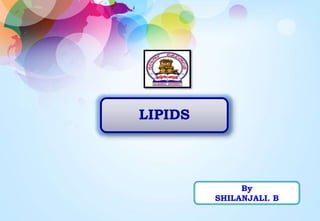
Biochemical concept of lipids
- 2. INTRODUCTION •Lipids are biological molecules that are insoluble in water but soluble in non-polar solvents. •Lipids have a wider spectrum of compositions and structures because they are defined in terms of their physical properties (water solubility). •Lipids are the waxy, greasy, or oily compounds found in plants and animals. •Wax coating that protects plants–used as energy storage–structural components(cell membranes) insulation against cold Michel Eugène Chevreul (1786-1889) Henri Braconnot (1780-1855)
- 3. The Fluid-Mosaic Model Most cell membranes contain about 60% lipids and 40% proteins
- 4. CLASSIFICATION OF LIPIDS •Lipids are divided into:– Saponifiable lipids —contain esters, which can undergo saponification (hydrolysis under basic conditions) (waxes, triglycerides, phospho- glycerides, sphingolipids) Non-saponifiable lipids —do not contain ester groups, and cannot be saponified (steroids, prostaglandins) •Saponifiable lipids can also be divided into groups:– Simple lipids —contain two types of components (a fatty acid and an alcohol) Complex lipids —contain more than two components (fatty acids, an alcohol, and other components)
- 6. Types structure •Fatty acids are long-chain carboxylic acids Fatty Acids
- 7. Properties of Fatty Acids •The long non-polar hydrocarbon tails of fatty acids are responsible for most of the fatty or oily characteristics of lipids. •The carboxyl (COOH) group is hydrophilic under basic conditions, such as physiological pH (7.4) carboxylicacid carboxylation
- 8. •In aqueous solutions, fatty acids associate with each other in spherical clusters called micelles, in which the hydrocarbon tails tangle each other up through dispersion forces, leaving a “shell” of polar carboxylate ions facing outwards, in contact with the water. •Micelles are important in the transport of insoluble lipids in the blood, and in the actions of soaps. Fatty Acid Micelles
- 9. Saturated and Unsaturated Fatty Acids •The cis-double bonds in unsaturated fatty acids put an inflexible “kink” in the carbon chain, preventing the molecules from packing together as tightly as saturated fatty acids do. – For example, stearic acid (saturated), oleic acid (one double- bond), and linoleic acid (two double bonds) all have 18 carbons in the chain, but their melting points are drastically different.
- 10. Essential Fatty Acids •Most of the fatty acids we need and can be synthesized in the body. •Two fatty acids, linoleic acid and linolenic acid, both polyunsaturated fatty acids with 18-carbon chains, cannot be synthesized in the body and must be obtained from the diet. •These are essential fatty acids, Both are found in plant and fish oils. •In the body, they are used to produce hormone like substances that regulate blood pressure, blood clotting, blood lipid levels, the immune response, and inflammatory reactions.
- 11. SL.No Name Formula MP Common Sources Saturated 1 Myristic acid CH3(CH2)12COOH 54ºC Butterfat, coconut oil, nutmeg oil 2 Palmitic acid CH3(CH2)14COOH 63ºC Lard, beef fat, butterfat, cottonseed oil 3 Stearic acid CH3(CH2)16COOH 70ºC Lard, beef fat, butterfat, cottonseed oil 4 Arachidic acid CH3(CH2)18COOH 76ºC Peanut oil Monounsaturated 5 Palmitoleic acid CH3(CH2)5CH=CH(CH2)7COOH -1ºC Cod liver oil, butterfat 6 Oleic acid CH3(CH2)7CH=CH(CH2)7COOH 13ºC Lard, beef fat, olive oil, peanut oil Polyunsaturated 7 Linoleic acid CH3(CH2)4(CH=CHCH2)2(CH2)6C OOH -5ºC Cottonseed oil, soybean oil, corn oil, linseed oil 8 Linolenic acid CH3CH2(CH=CHCH2)3(CH2)6CO OH -11ºC Linseed oil, corn oil 9 Arachidonic acid CH3(CH2)4(CH=CHCH2)4(CH2)2C OOH -50ºC Corn oil, linseed oil, animal tissues 10 Eicosapentaenoic acid CH3CH2(CH=CHCH2)5(CH2)2CO OH Fish oil, seafoods 11 Docosahexaenoic acid CH3CH2(CH=CHCH2)6CH2COOH Fish oil, seafoods Essential Fatty Acids
- 12. The Structure of Fats and Oils Triglycerides Triglycerides •Animal fats and vegetable oils are esters composed of three molecules of a fatty acid connected to a glycerol molecule, producing a structure called a triglyceride or a triacylglycerol:
- 13. The Structure of Fats and Oils •Fats are triglycerides that are solids at room temp. usually derived from animals mostly saturated fatty acids •Oils are triglycerides that are liquids at room temp. usually derived from plants or fish mostly unsaturated fatty acids Fats and Oils A comparison of saturated and unsaturated fatty acids in some foods.
- 14. Fats and Oils •Hydrolysis of Triglycerides Triglycerides can be broken apart with water and an acid catalyst (hydrolysis), or by digestive enzymes called lipases •Saponification of Triglycerides In saponification reactions, triglycerides react with strong bases (NaOH or KOH) to form the carboxylate salts of the fatty acids, called soaps: •Soaps NaOH produces a “hard” soap, commonly found in bar soaps; KOH produces a “soft” soap, such as those in shaving creams and liquid soaps. •Hydrogenation In hydrogenation reactions, alkenes are converted into alkanes with hydrogen gas (H2) and a catalyst (Pt, Ni, or some other metal). This process is used to convert unsaturated vegetable oils, which are liquids at room temp., to saturated fats, which are solids at room temp. (shortening, etc.). •Waxes Waxes are simple lipids contain a fatty acid joined to a long-chain (12-32 carbons) alcohol •Phosphoglycerides Phosphoglycerides are complex lipids that are major components of cell membranes. Phosphoglycerides and related compounds are also called phospholipids
- 15. STEROIDS •Steroids are classified as lipids because they are soluble in nonpolar solvents, but they are non- Saponifiable because the components are not held together by ester linkages. The basic steroid structure contains four fused rings
- 16. DOUBTS